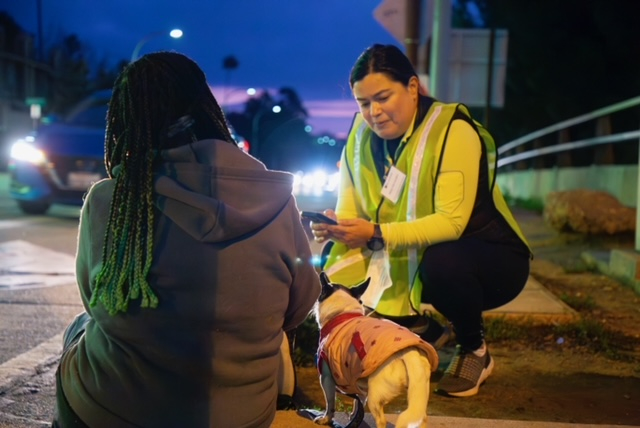The City of Pasadena and the Pasadena Partnership to End Homelessness conducted patrols throughout the city on Tuesday, January 23 and Wednesday, January 24 for the 2024 Homelessness Survey. (Courtesy of the City of Pasadena)
The city and county of Los Angeles made historic investments this fiscal year of $1.3 billion and $610 million, respectively, to combat homelessness, raising the question of whether the money has helped solve the crisis.
We will have some sort of answer on Friday, June 28, when the Los Angeles Homeless Services Authority (LAHSA) releases the results of the 2024 Los Angeles County Homeless Survey.
A survey last year found the number of homeless people was up 9 percent for the year and 91 percent higher than in the previous decade, disappointing many city and county leaders who had hoped the numbers would plateau or decline.
Now the pressure is on to do better.
LAHSA has faced harsh criticism for failing to demonstrate the impact of its spending, a lack of transparency in tracking data and insufficient coordination with cities and counties.
Earlier this year, the Los Angeles Union for Human Rights — which had sued the city and county for not doing enough to address homelessness — accused the city of not complying with the terms of an April 2022 settlement agreement to remove encampments and install shelter beds.
“I think there’s been a lot more questions and scrutiny across the board about where the billions of dollars that have been put into addressing homelessness and mental health issues over the last few years have been spent,” said Danielle Conway, who has worked on homelessness across California, including as a policy adviser to the Los Angeles League for Human Rights.
In March, U.S. District Judge David Carter ordered a comprehensive independent audit of all homeless assistance programs funded by the city of Los Angeles following a complaint from the coalition. In February, the Board of Supervisors ordered a financial audit of LAHSA’s spending.
But despite many concerns about Los Angeles’ homelessness spending, there are reasons to hope for positive changes in this year’s survey.
Since the 2023 count, Los Angeles Mayor Karen Bass has renewed her emergency declaration to address the crisis and strengthened her own Inside Safe program to move people living in encampments into housing, and the Board of Supervisors has followed suit, launching its own Pathway Home program in January 2023 to address tent and RV encampments.
“Both the Inside Safe and Pathway Home programs are well-serviced and appear to be doing a good job on the housing side, so we’re hopeful that through those two programs, we’ll see the numbers plateau or even go down a little bit,” said Patty St. Clair, a member of the Homeless Count Advisory Committee and former director of statistics and analysis for the USC Homeless Count team, “but who knows what will happen.”
The 2024 survey took place over three nights in January, with around 5,700 volunteers fanning out across the county to record every homeless person, tent and occupied vehicle they saw. These numbers will then be combined with data from demographic surveys conducted by researchers to generate insights into the size, location and characteristics of Los Angeles’ homeless population.
For example, the 2023 census estimates that Los Angeles County’s homeless population is approximately 75,500, including 32,000 chronically homeless people, 6,200 children, 4,700 seniors, and 3,900 veterans.
The results are used to determine the allocation of county and city resources for homeless assistance and to determine the amount of federal funding Los Angeles receives from the U.S. Department of Housing and Urban Development.
The number is not a perfect measure of the homeless population because it reflects observations at a single point in time and is subject to errors caused by volunteers and technology.
“The results should be interpreted as estimates of numbers within a margin of error,” St. Clair said, “but the methodology is consistent over time and gives a good picture of what’s going on.”
The oversight board ordered an audit of the study after minor glitches were reported in a smartphone app used by volunteer investigators in the field during the 2024 study. LAHSA said those issues did not affect data collection or storage.
Paul Webster, executive director of the Los Angeles League for Human Rights, said he wasn’t paying much attention to this year’s tally because even a modest decrease doesn’t change the fact that homelessness in Los Angeles is a major problem that has been steadily increasing for more than a decade.
“If we’re really going to treat this as an emergency as everyone is saying, then let’s look at the long-term data and stop making decisions based on small changes,” he said.
Webster believes there is a need to understand how funds are being used effectively, or not used, to address homelessness, and he is awaiting the results of the audit ordered by Judge Carter.
“If it’s been getting worse for 10 years, we need to make fundamental and fundamental changes to how we fund homelessness programs, how we select providers and how we hold the people who are spending the money accountable,” he said.
Conway, the coalition’s policy consultant, is excited about the audit’s findings and thinks they could prompt other counties to examine their homelessness spending and adjust their strategies accordingly.
“I think the audit could spark a conversation across the state that says, ‘We’re not getting the results we’d hoped for from our spending so far, so now is the time to reset,'” he said.
Last year, homelessness increased in nearly every county in California, home to 28% of the nation’s homeless population. By 2023, California’s homeless population will exceed 180,000, up 6% from the previous year and 53% from a decade ago.

